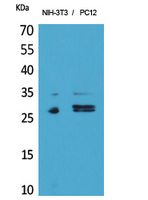DcR1 Polyclonal Antibody
- Catalog No.:YT5483
- Applications:WB;ELISA
- Reactivity:Human
- Target:
- DcR1
- Fields:
- >>Cytokine-cytokine receptor interaction;>>Viral protein interaction with cytokine and cytokine receptor
- Gene Name:
- TNFRSF10C
- Protein Name:
- Tumor necrosis factor receptor superfamily member 10C
- Human Gene Id:
- 8794
- Human Swiss Prot No:
- O14798
- Immunogen:
- The antiserum was produced against synthesized peptide derived from the Internal region of human TNFRSF10C. AA range:11-60
- Specificity:
- DcR1 Polyclonal Antibody detects endogenous levels of DcR1 protein.
- Formulation:
- Liquid in PBS containing 50% glycerol, 0.5% BSA and 0.02% sodium azide.
- Source:
- Polyclonal, Rabbit,IgG
- Dilution:
- WB 1:500 - 1:2000. ELISA: 1:20000. Not yet tested in other applications.
- Purification:
- The antibody was affinity-purified from rabbit antiserum by affinity-chromatography using epitope-specific immunogen.
- Concentration:
- 1 mg/ml
- Storage Stability:
- -15°C to -25°C/1 year(Do not lower than -25°C)
- Other Name:
- TNFRSF10C;DCR1;LIT;TRAILR3;TRID;Tumor necrosis factor receptor superfamily member 10C;Antagonist decoy receptor for TRAIL/Apo-2L;Decoy TRAIL receptor without death domainDecoy receptor 1;DcR1;Lymphocyte inhibitor of TRAIL;TNF-related apoptosis-inducing ligand receptor 3;TRAIL receptor 3;TRAIL-R3;TRAIL receptor without an intracellular domain;CD263
- Observed Band(KD):
- 27kD
- Background:
- The protein encoded by this gene is a member of the TNF-receptor superfamily. This receptor contains an extracellular TRAIL-binding domain and a transmembrane domain, but no cytoplasmic death domain. This receptor is not capable of inducing apoptosis, and is thought to function as an antagonistic receptor that protects cells from TRAIL-induced apoptosis. This gene was found to be a p53-regulated DNA damage-inducible gene. The expression of this gene was detected in many normal tissues but not in most cancer cell lines, which may explain the specific sensitivity of cancer cells to the apoptosis-inducing activity of TRAIL. [provided by RefSeq, Jul 2008],
- Function:
- function:Receptor for the cytotoxic ligand TRAIL. Lacks a cytoplasmic death domain and hence is not capable of inducing apoptosis. May protect cells against TRAIL mediated apoptosis by competing with TRAIL-R1 and R2 for binding to the ligand.,PTM:N-glycosylated and O-glycosylated.,similarity:Contains 3 TNFR-Cys repeats.,tissue specificity:Higher expression in normal tissues than in tumor cell lines. Highly expressed in peripheral blood lymphocytes, spleen, skeletal muscle, placenta, lung and heart.,
- Subcellular Location:
- Cell membrane; Lipid-anchor, GPI-anchor.
- Expression:
- Higher expression in normal tissues than in tumor cell lines. Highly expressed in peripheral blood lymphocytes, spleen, skeletal muscle, placenta, lung and heart.
- June 19-2018
- WESTERN IMMUNOBLOTTING PROTOCOL
- June 19-2018
- IMMUNOHISTOCHEMISTRY-PARAFFIN PROTOCOL
- June 19-2018
- IMMUNOFLUORESCENCE PROTOCOL
- September 08-2020
- FLOW-CYTOMEYRT-PROTOCOL
- May 20-2022
- Cell-Based ELISA│解您多样本WB检测之困扰
- July 13-2018
- CELL-BASED-ELISA-PROTOCOL-FOR-ACETYL-PROTEIN
- July 13-2018
- CELL-BASED-ELISA-PROTOCOL-FOR-PHOSPHO-PROTEIN
- July 13-2018
- Antibody-FAQs
- Products Images

- Western Blot analysis of NIH-3T3, PC12 cells using DcR1 Polyclonal Antibody. Secondary antibody(catalog#:RS0002) was diluted at 1:20000



